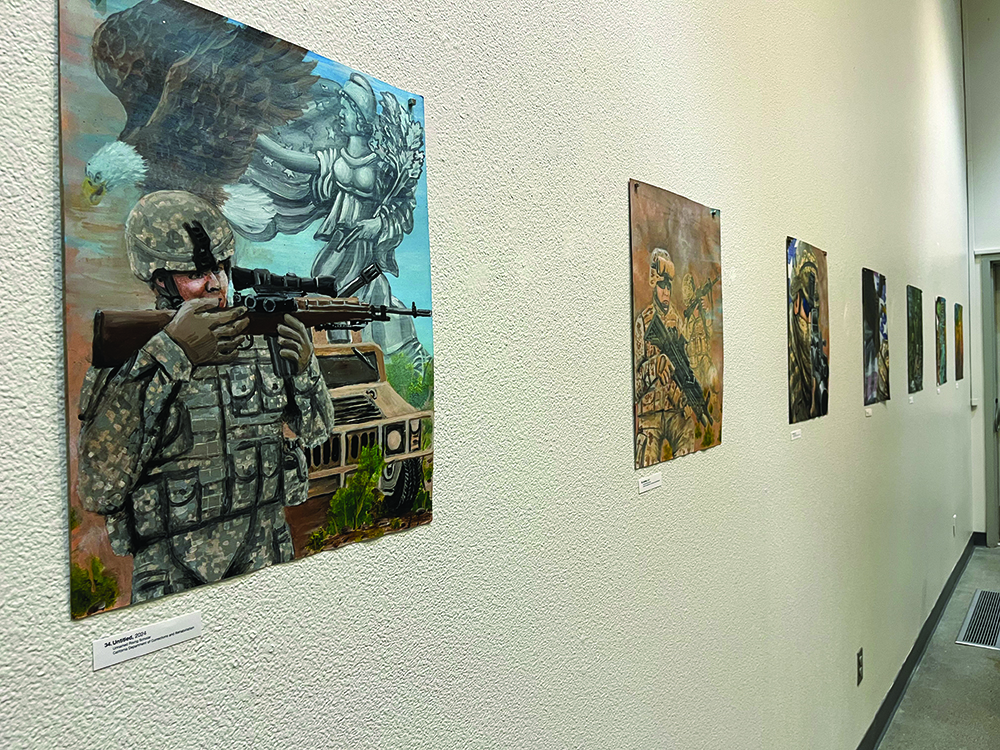Artist and art professor at University of Alaska, Tom Chung, gave a lecture showing and explaining his works March 11 at Bakersfield College. The next day he put his works of art, titled “Drapetomania,” in the Wylie and May Louise Jones Gallery.
“Drapetomania” is a selection of large monochromatic acrylic paintings on large canvases that have been framed with branches of trees and twine. Chung’s work illustrates the recent time he has spent in Alaska, most of the pieces contain Chung in them and he says that since he is in the art it’s like he is giving a performance for you each time you look at a piece.
“I am looking at you and for you,” said Chung.
This is the first time Chung has done a whole selection in just black and gray.
All of the pieces for “Drapetomania” were all made within about the last six months.
“I usually work really fast because I get bored really easy,” said Chung.
The largest piece in the gallery is called “I Really Caribou You.” Next to the painting is a quote under the title of the painting that read, “I was driving in my 26-year-old jeep the first time I saw a moose. I thought it was a bronze statue, and then it looked at me.”
“Drapetomania” will be up in the gallery until April 8.
“Basically, you’re watching me descend into madness in Alaska,” said Chung.
During the lecture on March 11, Chung showed and spoke about most of his works from when he was studying at San Francisco Art Institute, to when he was a student at Yale School of Art, works from when he lived in Hawaii and now while living in Alaska.
A lot of Chung’s early work that he presented was heavily influenced around him growing up in a white America explained Chung.
“I grew up in a small white suburb in New Jersey, I was the only person in my elementary school that wasn’t white,” said Chung. Chung also went to middle school in Hong Kong.
Chung also showed work from the time he spent in San Francisco, where Chung took tropes of how Asian males were perceived in American culture and hyper-sexualized it in effort to overwrite those particular tropes when someone would look at his art.
Because Chung’s mother was in the advertising business, he was always noticing the effects that the media had on everyone surrounding him.
“Every Asian male in the media, on TV…was always this desexualized sort of character, this joke.”
Before graduate school, Chung decided to live in the woods of Virginia for a while to see if he could survive. He ended up living mostly off of snakes and fennel. Chung later explained that a person can eat pretty much any snake as long as the head is cut off below the venom sacs. While in the woods of Virginia, Chung would come across hunting platforms. He would then take his art and collage them on the platforms with resin so that they would be almost impossible to remove.
“Sometimes I just like to make mischief,” said Chung.
But Chung missed some things that civilization had to offer that the woods did not.
“I missed toilets,” said Chung.
Chung’s main body of work while in graduate school was mainly based around Ayahuasca, a plant brew containing the hallucinogen DMT. Chung would consume the Ayahuasca, then produce art about his experiences.
Soon after, Chung was able to get a grant to go to the Amazon Basin where they had been using Ayahuasca for thousands of years. But Chung’s goal was to ultimately get as far away from the western culture as he could,
“Culture can be a really powerful force itself and referred to as the third parent,” said Chung.
The pieces shown were those inspired from the time he spent living in the villages with the natives of the Amazon Basin and taking spiritual trips on Ayahuasca.
“[The shaman] forced me to drink hallucinogens every day for two weeks ,and I thought I was going to die, like all the time.”
Chung also showed art works from his time in Hawaii and from the time he has spent in Alaska, which include the selections in “Drapetomania.”
Chung also happens to be red and green colorblind. In Chung’s case, there is an absence of those colors, but Chung doesn’t let it affect his art.
“I know when to be suspicious,” said Chung.
Chung can be found in a good majority of his art, as he puts himself in it, as well as Chung’s current setting. Chung believes he fits right into the genre of identity politics, where the artist’s identity becomes very important when it comes to the art itself.
“The underlying basis of my work I believe is, that I’m investigating what makes us human,” said Chung.
When it comes to art there is one thing Chung always tells his students.
“Good art always asks more questions than it answers,” said Chung.
You can check out more of Chung’s art at tomchung.org.





